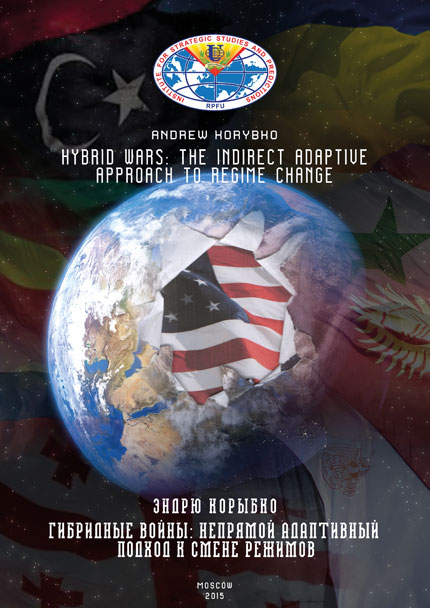
Гибридные войны: непрямой адаптивный подход к смене режимов
Автор: Andrew Korybko (Эндрю Корыбко)
Издательство: Российский университет дружбы народов
ISBN: 978-5-209-06595-1
Год: 2015
Оглавление
Summary
Introduction
Introduction 0.1: Topical Significance
Introduction 0.2: Theory
Introduction 0.3: Official Russian Position to theTopic
Introduction 0.4: The Shortcomings of the Russian Position
Introduction 0.5: Object, Subject, Scope, and Aim of the Book
Introduction 0.6: Methodology
Chapter 1: Theoretical Contexts
Chapter 1.1.1: Geopolitical Context
Chapter 1.1.2: Mahan and Mackinder
Chapter 1.1.3: Prometheism
Chapter 1.1.4: The Rimland and Shatterbelt
Chapter 1.1.5: The Eurasian Balkans
Chapter 1.1.6: Geopolitical Context Summary
Chapter 1.2.1: Military Theories
Chapter 1.2.2: Fourth Generation Warfare
Chapter 1.2.3: The Five Rings
Chapter 1.2.4: The Indirect Approach and the OODA Loop
Chapter 1.2.5: Chaos Theory
Chapter 1.2.6: Lead From Behind
Chapter 1.2.7: Military Theories Summary
Chapter 1.3.1: Full Spectrum Dominance
Chapter 1.3.2: Full Spectrum Dominance and Color Revolutions
Chapter 1.3.3: Full Spectrum Dominance and Unconventional Warfare
Chapter 1.3.4: The Dominance of Chaotic Dynamics
Chapter 1.3.5: Full Spectrum Dominance Summary
Chapter 1.4: Chapter Conclusion
Chapter 2: Color Revolution Application
Chapter 2.1.1: Introduction to Theory and Strategy
Chapter 2.1.2: "Propaganda" and "The Engineering of Consent"
Chapter 2.1.3: Reverse Neocortical Warfare
Chapter 2.1.4: Social Network-Centric Warfare
Chapter 2.1.5: Social Network War
Chapter 2.1.6: Facebook Case Study
Chapter 2.2.1: Swarming and the Hive Mind
Chapter 2.2.2: Swarming and Color Revolutions
Chapter 2.3.1: The Tactics and Practice of Color Revolutions
Chapter 2.3.2: "The Machiavelli of Non-Violence"
Chapter 2.3.3: The Color Revolution Field Manual
Chapter 2.4.1: Notable Color Revolution Practitioners
Chapter 2.4.2: John Tefft
Chapter 2.4.3: Frank Archibald
Chapter 2.5: Chapter Conclusion
Chapter 3: Unconventional Warfare Application
Chapter 3.1: What is Unconventional Warfare?
Chapter 3.2: History and Advantages
Chapter 3.3: The Rise of Non-State Actors and Special Forces
Chapter 3.4.1: Unconventional Warfare Strategy
Chapter 3.4.2: The Five Rings
Chapter 3.4.3: The Indirect Approach and the OODA Loop
Chapter 3.4.4: Network War and Swarming
Chapter 3.4.5: Chaos Theory
Chapter 3.5.1: The Unconventional Warfare Field Manual
Chapter 3.5.2: Preparing for the Unconventional War
Chapter 3.5.3: Waging the Unconventional War
Chapter 3.6: Unconventional War in Ukraine
Chapter 3.7: Chapter Conclusion
Chapter 4: The Bridge
Chapter 4.1: Introduction
Chapter 4.2: Geopolitical Relationship
Chapter 4.3: The Field Manuals
Chapter 4.4: Shared Strategies
Chapter 4.5: Side-By-Side Comparison
Chapter 4.6: Archibald Crosses the Rubicon
Conclusion
Conclusion 5.1: Limited Forecast
Conclusion 5.2: General Recommendations
Conclusion 5.3: Concluding Thoughts
Appendix I: An Expose Of The Core Color Revolution Mechanics
Appendix II: The Color Arc
Bibliography


